

Compact Muon Solenoid
LHC, CERN
| CMS-TOP-16-023 ; CERN-EP-2017-258 | ||
| Measurement of the inclusive $\mathrm{t\bar{t}}$ cross section in pp collisions at $\sqrt{s} = $ 5.02 TeV using final states with at least one charged lepton | ||
| CMS Collaboration | ||
| 8 November 2017 | ||
| JHEP 03 (2018) 115 | ||
| Abstract: The top quark pair production cross section (${\sigma_{\mathrm{t\bar{t}}}} $) is measured for the first time in pp collisions at a center-of-mass energy of 5.02 TeV. The data were collected by the CMS experiment at the LHC and correspond to an integrated luminosity of 27.4 pb$^{-1}$. The measurement is performed by analyzing events with at least one charged lepton. The measured cross section is $ {\sigma_{\mathrm{t\bar{t}}}} = $ 69.5 $\pm$ 6.1 (stat) $\pm$ 5.6 (syst) $\pm$ 1.6 (lumi) pb, with a total relative uncertainty of 12%. The result is in agreement with the expectation from the standard model. The impact of the presented measurement on the determination of the gluon distribution function is investigated. | ||
| Links: e-print arXiv:1711.03143 [hep-ex] (PDF) ; CDS record ; inSPIRE record ; HepData record ; CADI line (restricted) ; | ||
| Figures & Tables | Summary | Additional Figures | References | CMS Publications |
|---|
| Figures | |
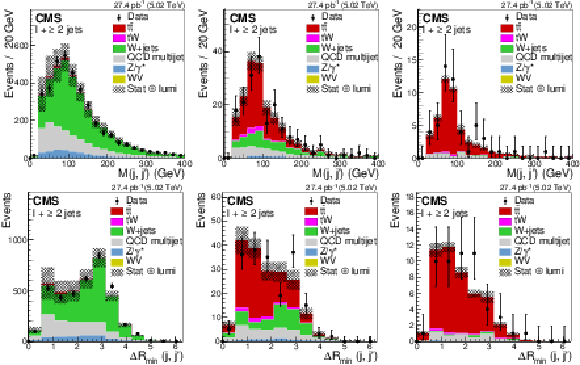
png pdf |
Figure 1:
The predicted and observed distributions of the (upper row) $M(j,j')$ and (lower row) ${\Delta R_\text {min}(j,j')}$ variable for $\ell $+jets events in the 0 b (left), 1 b (center), and $\geq $2 b (right) tagged jet categories. The distributions from data are compared to the sum of the expectations for the signal and backgrounds prior to any fit. The QCD multijet background is estimated from data (see Section 5.1). The cross-hatched band represents the statistical and the integrated luminosity uncertainties in the expected signal and background yields added in quadrature. The vertical bars on the data points represent the statistical uncertainties. |

png pdf |
Figure 1-a:
The predicted and observed distributions of the $M(j,j')$ variable for $\ell $+jets events in the 0 b tagged jet category. The distributions from data are compared to the sum of the expectations for the signal and backgrounds prior to any fit. The QCD multijet background is estimated from data (see Section 5.1). The cross-hatched band represents the statistical and the integrated luminosity uncertainties in the expected signal and background yields added in quadrature. The vertical bars on the data points represent the statistical uncertainties. |
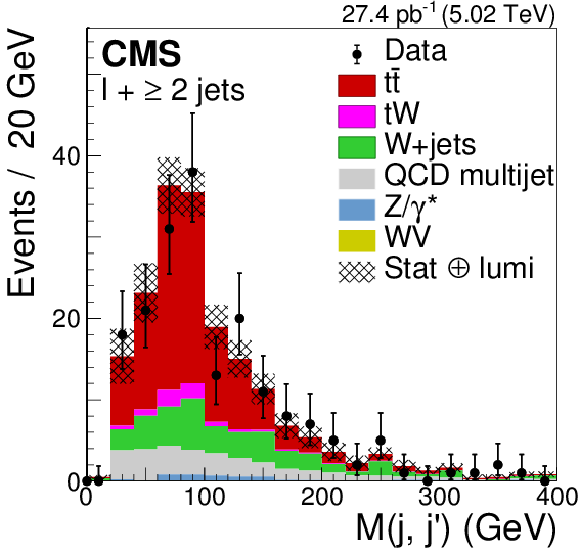
png pdf |
Figure 1-b:
The predicted and observed distributions of the $M(j,j')$ variable for $\ell $+jets events in the 1 b tagged jet category. The distributions from data are compared to the sum of the expectations for the signal and backgrounds prior to any fit. The QCD multijet background is estimated from data (see Section 5.1). The cross-hatched band represents the statistical and the integrated luminosity uncertainties in the expected signal and background yields added in quadrature. The vertical bars on the data points represent the statistical uncertainties. |
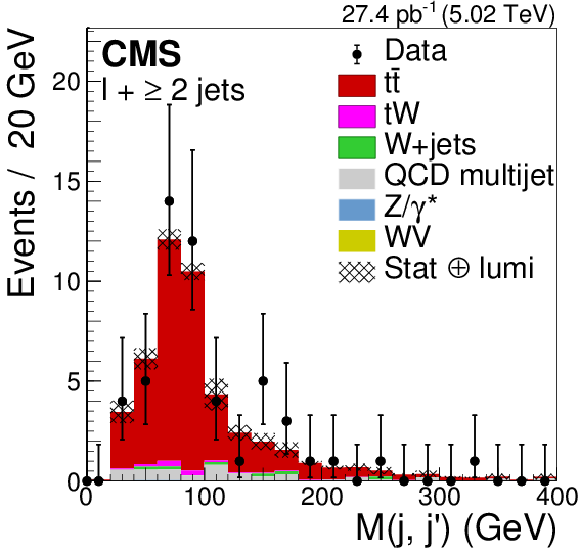
png pdf |
Figure 1-c:
The predicted and observed distributions of the $M(j,j')$ variable for $\ell $+jets events in the $\geq $2 b tagged jet category. The distributions from data are compared to the sum of the expectations for the signal and backgrounds prior to any fit. The QCD multijet background is estimated from data (see Section 5.1). The cross-hatched band represents the statistical and the integrated luminosity uncertainties in the expected signal and background yields added in quadrature. The vertical bars on the data points represent the statistical uncertainties. |
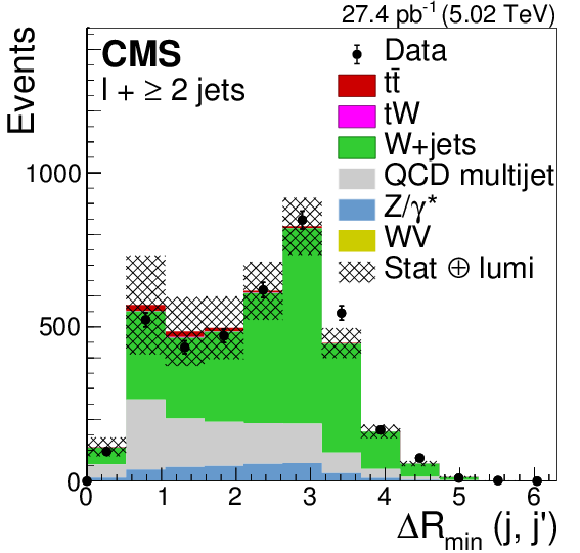
png pdf |
Figure 1-d:
The predicted and observed distributions of the ${\Delta R_\text {min}(j,j')}$ variable for $\ell $+jets events in the 0 b tagged jet category. The distributions from data are compared to the sum of the expectations for the signal and backgrounds prior to any fit. The QCD multijet background is estimated from data (see Section 5.1). The cross-hatched band represents the statistical and the integrated luminosity uncertainties in the expected signal and background yields added in quadrature. The vertical bars on the data points represent the statistical uncertainties. |
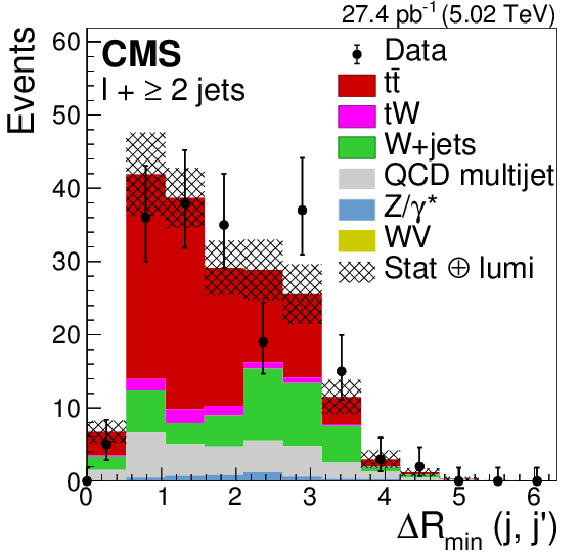
png pdf |
Figure 1-e:
The predicted and observed distributions of the ${\Delta R_\text {min}(j,j')}$ variable for $\ell $+jets events in the 1 b tagged jet category. The distributions from data are compared to the sum of the expectations for the signal and backgrounds prior to any fit. The QCD multijet background is estimated from data (see Section 5.1). The cross-hatched band represents the statistical and the integrated luminosity uncertainties in the expected signal and background yields added in quadrature. The vertical bars on the data points represent the statistical uncertainties. |

png pdf |
Figure 1-f:
The predicted and observed distributions of the ${\Delta R_\text {min}(j,j')}$ variable for $\ell $+jets events in the $\geq $2 b tagged jet category. The distributions from data are compared to the sum of the expectations for the signal and backgrounds prior to any fit. The QCD multijet background is estimated from data (see Section 5.1). The cross-hatched band represents the statistical and the integrated luminosity uncertainties in the expected signal and background yields added in quadrature. The vertical bars on the data points represent the statistical uncertainties. |

png pdf |
Figure 2:
Left: The 68% CL contour obtained from the scan of the likelihood in $\ell $+jets analysis, as a function of $\mu $ and $\mathrm {SF}_{\mathrm{b}}$ in the $\ell $+jets analysis. The solid (dashed) contour refers to the result from data (expectation from simulation). The solid (hollow) diamond represents the observed fit result (SM expectation). Right: Summary of the signal strengths separately obtained in the e+jets and $\mu $+jets channels, and after their combination in the $\ell $+jets channel. The results of the analysis from the distributions are compared to those from the cross-check analysis with event counting (Count). The inner (outer) bars correspond to the statistical (total) uncertainty in the signal strengths. |
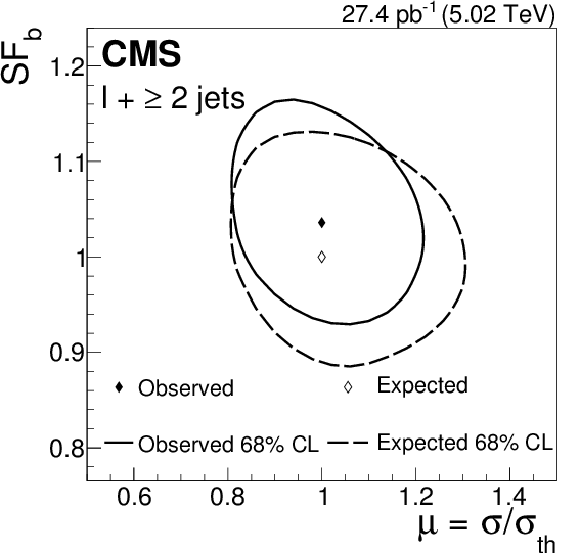
png pdf |
Figure 2-a:
The 68% CL contour obtained from the scan of the likelihood in $\ell $+jets analysis, as a function of $\mu $ and $\mathrm {SF}_{\mathrm{b}}$ in the $\ell $+jets analysis. The solid (dashed) contour refers to the result from data (expectation from simulation). The solid (hollow) diamond represents the observed fit result (SM expectation). |
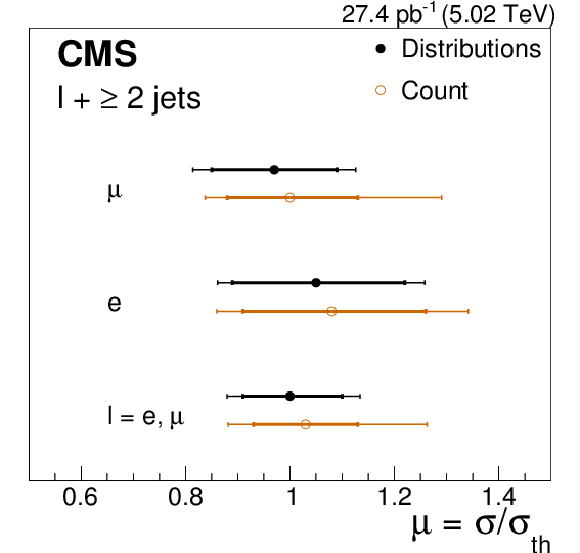
png pdf |
Figure 2-b:
Summary of the signal strengths separately obtained in the e+jets and $\mu $+jets channels, and after their combination in the $\ell $+jets channel. The results of the analysis from the distributions are compared to those from the cross-check analysis with event counting (Count). The inner (outer) bars correspond to the statistical (total) uncertainty in the signal strengths. |
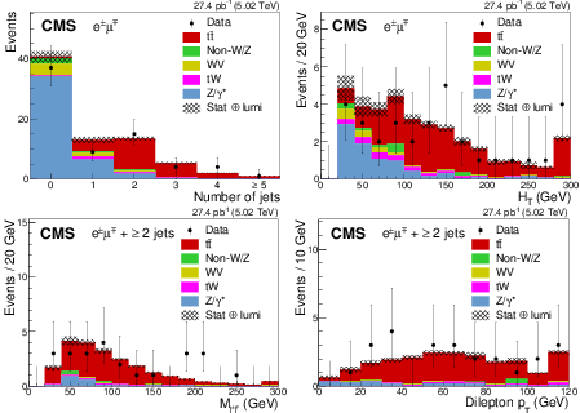
png pdf |
Figure 3:
Predicted and observed distributions of the (upper row) jet multiplicity and scalar ${p_{\mathrm {T}}}$ sum of all jets ($H_\mathrm {T}$) for events passing the dilepton criteria, and of the (lower row) invariant mass and ${p_{\mathrm {T}}}$ of the lepton pair after requiring at least two jets, in the $\mathrm{e}^{\pm} \mu^{\mp}$ channel. The Z/$\gamma ^{*}$ and non-W/Z backgrounds are determined from data (see Section 6.2). The cross-hatched band represents the statistical and integrated luminosity uncertainties in the expected signal and background yields added in quadrature. The vertical bars on the data points represent the statistical uncertainties. The last bin of the distributions contains the overflow events. |

png pdf |
Figure 3-a:
Predicted and observed distributions of the jet multiplicity for events passing the dilepton criteria. The Z/$\gamma ^{*}$ and non-W/Z backgrounds are determined from data (see Section 6.2). The cross-hatched band represents the statistical and integrated luminosity uncertainties in the expected signal and background yields added in quadrature. The vertical bars on the data points represent the statistical uncertainties. The last bin of the distribution contains the overflow events. |

png pdf |
Figure 3-b:
Predicted and observed distributions of the scalar ${p_{\mathrm {T}}}$ sum of all jets ($H_\mathrm {T}$) for events passing the dilepton criteria. The Z/$\gamma ^{*}$ and non-W/Z backgrounds are determined from data (see Section 6.2). The cross-hatched band represents the statistical and integrated luminosity uncertainties in the expected signal and background yields added in quadrature. The vertical bars on the data points represent the statistical uncertainties. The last bin of the distribution contains the overflow events. |
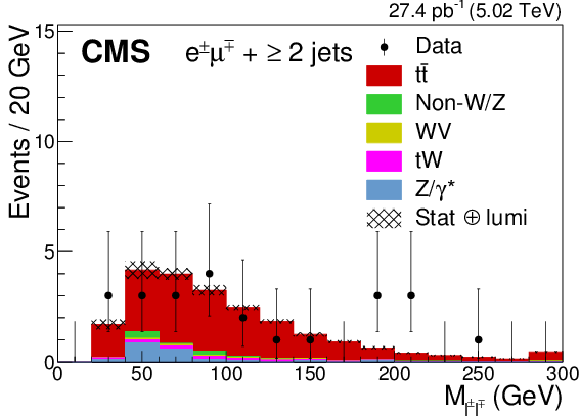
png pdf |
Figure 3-c:
Predicted and observed distributions of the invariant mass of the lepton pair after requiring at least two jets, in the $\mathrm{e}^{\pm} \mu^{\mp}$ channel. The Z/$\gamma ^{*}$ and non-W/Z backgrounds are determined from data (see Section 6.2). The cross-hatched band represents the statistical and integrated luminosity uncertainties in the expected signal and background yields added in quadrature. The vertical bars on the data points represent the statistical uncertainties. The last bin of the distribution contains the overflow events. |
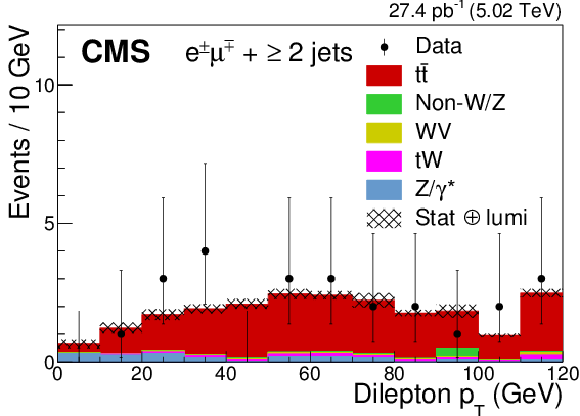
png pdf |
Figure 3-d:
Predicted and observed distributions of the ${p_{\mathrm {T}}}$ of the lepton pair after requiring at least two jets, in the $\mathrm{e}^{\pm} \mu^{\mp}$ channel. The Z/$\gamma ^{*}$ and non-W/Z backgrounds are determined from data (see Section 6.2). The cross-hatched band represents the statistical and integrated luminosity uncertainties in the expected signal and background yields added in quadrature. The vertical bars on the data points represent the statistical uncertainties. The last bin of the distribution contains the overflow events. |

png pdf |
Figure 4:
Predicted and observed distributions of the (left) ${{p_{\mathrm {T}}} ^\text {miss}}$ in events passing the dilepton criteria and Z boson veto, and of the (right) invariant mass of the lepton pair after the $ {{p_{\mathrm {T}}} ^\text {miss}} > $ 35 GeV requirement in the $\mu^{\pm} \mu^{\mp}$ channel. The cross-hatched band represents the statistical and integrated luminosity uncertainties in the expected signal and background yields added in quadrature. The vertical bars on the data points represent the statistical uncertainties. The last bin of the distributions contains the overflow events. |
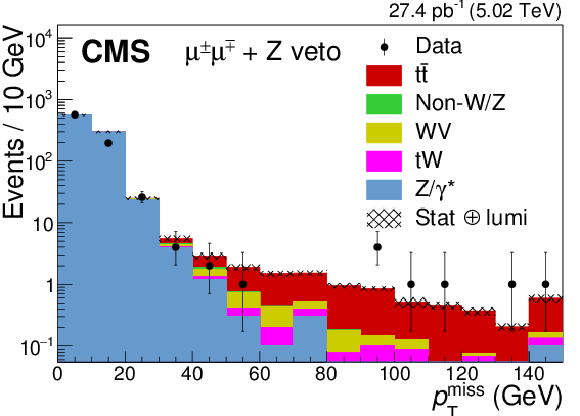
png pdf |
Figure 4-a:
Predicted and observed distributions of the ${{p_{\mathrm {T}}} ^\text {miss}}$ in events passing the dilepton criteria and Z boson veto in the $\mu^{\pm} \mu^{\mp}$ channel. The cross-hatched band represents the statistical and integrated luminosity uncertainties in the expected signal and background yields added in quadrature. The vertical bars on the data points represent the statistical uncertainties. The last bin of the distributions contains the overflow events. |
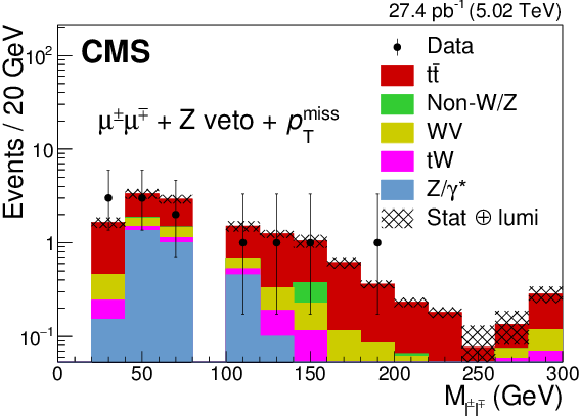
png pdf |
Figure 4-b:
Predicted and observed distributions of the invariant mass of the lepton pair after the $ {{p_{\mathrm {T}}} ^\text {miss}} > $ 35 GeV requirement in the $\mu^{\pm} \mu^{\mp}$ channel. The cross-hatched band represents the statistical and integrated luminosity uncertainties in the expected signal and background yields added in quadrature. The vertical bars on the data points represent the statistical uncertainties. The last bin of the distributions contains the overflow events. |
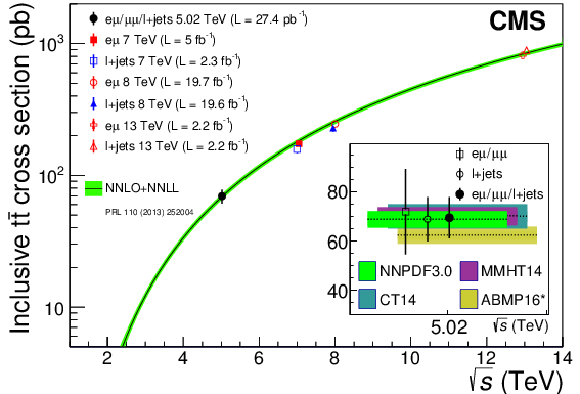
png pdf |
Figure 5:
Inclusive ${\sigma _{{\mathrm{t} {}\mathrm{\bar{t}}}}}$ in pp collisions as a function of the center-of-mass energy; previous CMS measurements at $ {\sqrt {s}} = $ 7, 8 [5,6], and 13 [9,10] TeV in the separate $\ell $+jets and dilepton channels are displayed, along with the combined measurement at 5.02 TeV from this analysis. The NNLO+NNLL theoretical prediction [33] using the NNPDF3.0 [13] PDF set with $\alpha _\mathrm {s}(M_{{\mathrm{Z}}})= $ 0.118 and $m_\text {top} = $ 172.5 GeV is shown in the main plot. In the inset, additional predictions at $ {\sqrt {s}} = $ 5.02 TeV using the MMHT14 [53], CT14 [54], and ABMP16 [55] PDF sets, the latter with $\alpha _\mathrm {s}(M_{{\mathrm{Z}}})= $ 0.115 and $m_\text {top} = $ 170.4 GeV, are compared, along with the NNPDF3.0 prediction, to the individual and combined results from this analysis. The vertical bars and bands represent the total uncertainties in the data and in the predictions, respectively. |

png pdf |
Figure 6:
The relative uncertainties in the gluon distribution function of the proton as a function of $x$ at $\mu ^2_{\mathrm {F}}=10^5 $ GeV$^2$ from a QCD analysis using the HERA DIS and CMS muon charge asymmetry measurements (hatched area), and also including the CMS ${\sigma _{{\mathrm{t} {}\mathrm{\bar{t}}}}}$ results at $ {\sqrt {s}} = $ 5.02 TeV (solid area). The relative uncertainties are found after the two gluon distributions have been normalized to unity. The solid line shows the ratio of the gluon distribution function found from the fit with the CMS ${\sigma _{{\mathrm{t} {}\mathrm{\bar{t}}}}}$ measurements included to that found without. |
| Tables | |

png pdf |
Table 1:
The number of expected background and signal events and the observed event yields in the different b tag categories for the e+jets and $\mu $+jets analyses, prior to the fit. With the exception of the QCD multijet estimate, for which the total uncertainty is reported, the uncertainties reflect the statistical uncertainty in the simulated samples. |

png pdf |
Table 2:
Estimated impact of each source of uncertainty in the value of $\mu $ extracted from the analysis of distributions, and in the cross-check from event counting. The "Other background'' component includes the contributions from Z/$\gamma ^{*}$, tW, and WV events. The total uncertainty is obtained by adding in quadrature the statistical, experimental systematic, and theoretical uncertainties. The individual experimental uncertainties are obtained by repeating the fit after fixing one nuisance parameter at a time at its post-fit uncertainty ($\pm $1 standard deviation) value. The values quoted have been symmetrized. |
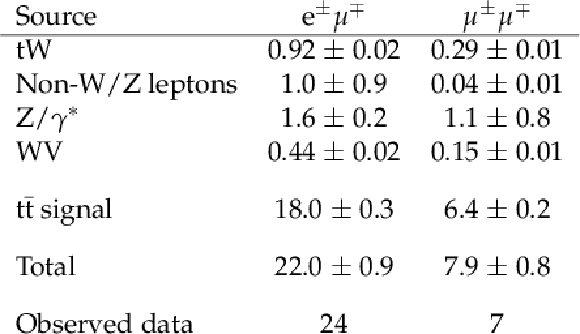
png pdf |
Table 3:
The predicted and observed numbers of dilepton events obtained after applying the full selection. The values are given for the individual sources of background, ${\mathrm{t} {}\mathrm{\bar{t}}}$ signal, and data. The uncertainties correspond to the statistical component. |

png pdf |
Table 4:
Summary of the individual contributions to the systematic uncertainty in the $ {\sigma _{{\mathrm{t} {}\mathrm{\bar{t}}}}} $ measurements for the dilepton channels. The relative uncertainties $\Delta {\sigma _{{\mathrm{t} {}\mathrm{\bar{t}}}}} / {\sigma _{{\mathrm{t} {}\mathrm{\bar{t}}}}} $ (in%), as well as absolute uncertainties in ${\sigma _{{\mathrm{t} {}\mathrm{\bar{t}}}}}$, $\Delta {\sigma _{{\mathrm{t} {}\mathrm{\bar{t}}}}} $ (in pb), are presented. The statistical and total uncertainties are also given, where the latter are the quadrature sum of the statistical and systematic uncertainties. |
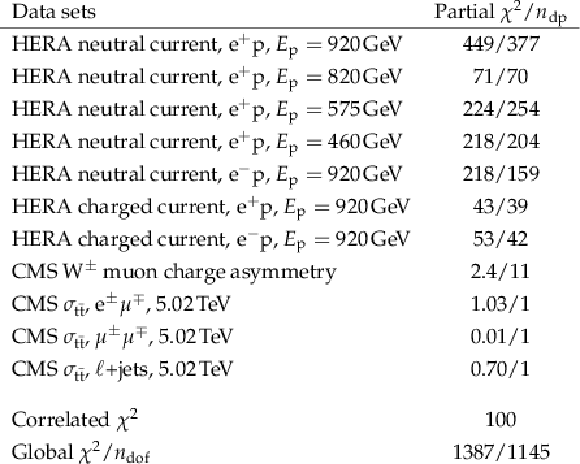
png pdf |
Table 5:
Partial $\chi ^2$ per number of data points, $n_{\mathrm {dp}}$, and the global $\chi ^2$ per degrees of freedom, $n_{\text {dof}}$, as obtained in the QCD analysis of DIS data, the CMS muon charge asymmetry measurements, and the ${\sigma _{{\mathrm{t} {}\mathrm{\bar{t}}}}}$ results at $ {\sqrt {s}} = $ 5.02 TeV from this analysis. For the HERA measurements, the energy of the proton beam ($E_{{\mathrm{p}}}$) is listed for each data set, with the electron/positron energy of 27.5 GeV. The correlated part of the global $\chi ^2$ value is also given. |
| Summary |
| The first measurement of the top quark pair ($\mathrm{t\bar{t}}$) production cross section in pp collisions at ${\sqrt{s}} = $ 5.02 TeV is presented for events with one or two leptons and at least two jets, using a data sample collected by the CMS experiment, corresponding to an integrated luminosity of 27.4 $\pm$ 0.6 pb$^{-1}$ . The final measurement is obtained from the combination of the measurements in the individual channels. The result is ${\sigma_{\mathrm{t\bar{t}}}} =$ 69.5 $\pm$ 6.1 (stat) $\pm$ 5.6 (syst) $\pm$ 1.6 (lumi) pb, with a total relative uncertainty of 12%, which is consistent with the standard model prediction. The impact of the measured $\mathrm{t\bar{t}}$ cross section in the determination of the parton distribution functions of the proton is studied in a quantum chromodynamics analysis at next-to-next-to-leading order. A moderate decrease of the uncertainty in the gluon distribution is observed at high values of $x$, the fractional momentum of the proton carried by the gluon. |
| Additional Figures | |
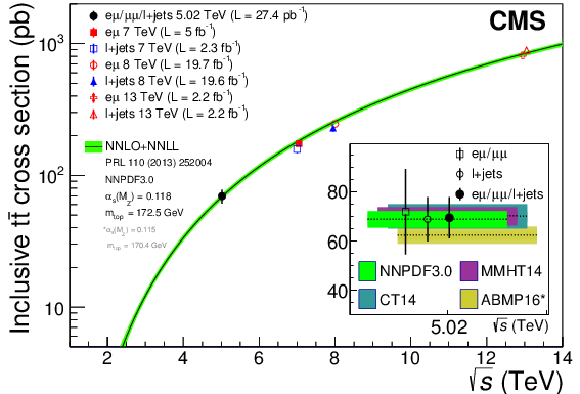
png pdf |
Additional Figure 1:
Inclusive ${\sigma_{{\mathrm{t} {}\mathrm{\bar{t}}}}}$ in pp collisions as a function of the center-of-mass energy; previous CMS measurements at $ {\sqrt {s}} = $ 7, 8 [5,6], and 13 [9,10] TeV in the separate $\ell $+jets and dilepton channels are displayed, along with the combined measurement at 5.02 TeV from this analysis. The NNLO+NNLL theoretical prediction [34] using the NNPDF3.0 [14] PDF set with $\alpha _{\rm s}(M_{\rm Z})= $ 0.118 and $m_{\rm {top}}= $ 172.5 GeV is shown in the main plot. In the inset, additional predictions at $ {\sqrt {s}} = $ 5.02 TeV using the MMHT14 [54], CT14 [55], and ABMP16 [56] PDF sets, the latter with $\alpha _{\rm s}(M_{\rm Z})= $ 0.115 and $m_{\rm {top}} = $ 170.4 GeV, are compared, along with the NNPDF3.0 prediction, to the individual and combined results from this analysis. The vertical bars and bands represent the total uncertainties in the data and in the predictions, respectively. |

png pdf |
Additional Figure 2:
Summary of the impacts and pulls of the most significant nuisance parameters used in the count analysis (left) and in the analysis of distributions (right), when the fit is performed to the Asimov dataset. In each plot the left panel shows the post-fit pull (value and uncertainty) of each nuisance, while the right panel displays the estimated impact on the fit for the signal strength. Only the first thirty nuisances are displayed, being their name shown at each row of the plots. |
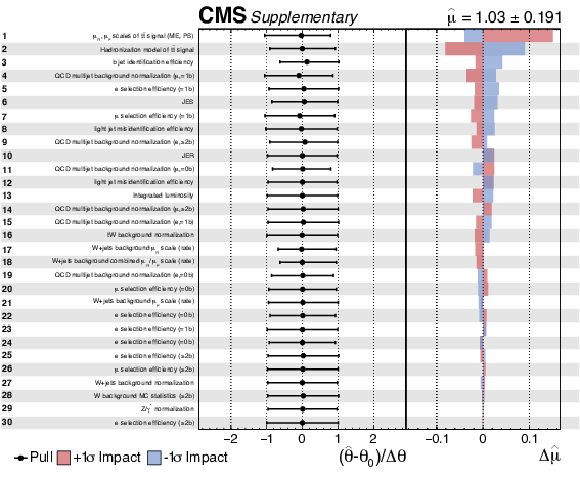
png pdf |
Additional Figure 2-a:
Summary of the impacts and pulls of the most significant nuisance parameters used in the count analysis, when the fit is performed to the Asimov dataset. The left panel shows the post-fit pull (value and uncertainty) of each nuisance, while the right panel displays the estimated impact on the fit for the signal strength. Only the first thirty nuisances are displayed, being their name shown at each row of the plot. |
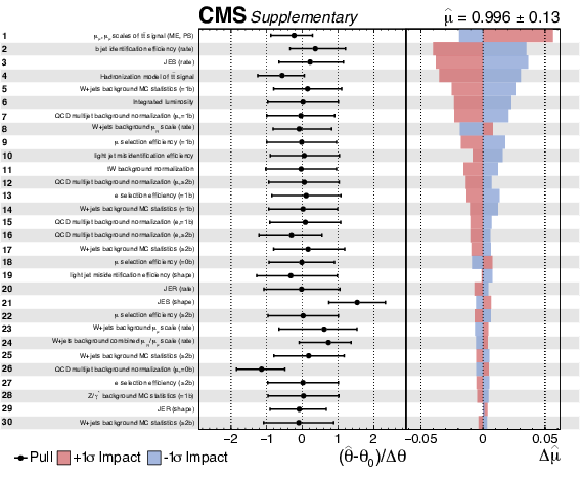
png pdf |
Additional Figure 2-b:
Summary of the impacts and pulls of the most significant nuisance parameters used in the analysis of distributions, when the fit is performed to the Asimov dataset. The left panel shows the post-fit pull (value and uncertainty) of each nuisance, while the right panel displays the estimated impact on the fit for the signal strength. Only the first thirty nuisances are displayed, being their name shown at each row of the plot. |
| References | ||||
| 1 | CMS Collaboration | Determination of the top-quark pole mass and strong coupling constant from the $ \mathrm{t}\overline{\mathrm{t}} $ production cross section in pp collisions at $ \sqrt{s} = $ 7 TeV | PLB 728 (2013) 496 | CMS-TOP-12-022 1307.1907 |
| 2 | CMS Collaboration | Measurement of double-differential cross sections for top quark pair production in pp collisions at $ \sqrt{s} = $ 8 TeV and impact on parton distribution functions | EPJC 77 (2017) 459 | CMS-TOP-14-013 1703.01630 |
| 3 | ATLAS Collaboration | Measurement of the top quark pair production cross-section with ATLAS in the single lepton channel | PLB 711 (2012) 244 | 1201.1889 |
| 4 | ATLAS Collaboration | Measurement of the $ \mathrm{t \bar{t}} $ production cross-section using $ \mathrm{e} \mu $ events with $ \rm{b} $-tagged jets in pp collisions at $ \sqrt{s}= $ 7 and 8 TeV with the ATLAS detector | EPJC 74 (2014) 3109 | 1406.5375 |
| 5 | CMS Collaboration | Measurement of the $ \mathrm{t\bar{t}} $ production cross section in the e$ \mu $ channel in proton-proton collisions at $ \sqrt{s} = $ 7 and 8 TeV | JHEP 08 (2016) 029 | CMS-TOP-13-004 1603.02303 |
| 6 | CMS Collaboration | Measurements of the $ \mathrm{t\bar{t}} $ production cross section in lepton+jets final states in pp collisions at 8 TeV and ratio of 8 to 7 TeV cross sections | EPJC 77 (2017) 15 | CMS-TOP-12-006 1602.09024 |
| 7 | ATLAS Collaboration | Measurement of the $ \mathrm{t \bar{t}} $ production cross-section using $ \mathrm{e} \mu $ events with b-tagged jets in pp collisions at $ \sqrt{s} = $ 13 TeV with the ATLAS detector | PLB 761 (2016) 136 | 1606.02699 |
| 8 | CMS Collaboration | Measurement of the top quark pair production cross section in proton-proton collisions at $ \sqrt{s} = $ 13 TeV | PRL 116 (2016) 052002 | CMS-TOP-15-003 1510.05302 |
| 9 | CMS Collaboration | Measurement of the $ \mathrm{t \bar{t}} $ production cross section using events in the $ \mathrm{e} \mu $ final state in pp collisions at $ \sqrt{s} = $ 13 TeV | EPJC 77 (2017) 172 | CMS-TOP-16-005 1611.04040 |
| 10 | CMS Collaboration | Measurement of the $ \mathrm{t}\overline{\mathrm{t}} $ production cross section using events with one lepton and at least one jet in pp collisions at $ \sqrt{s}= $ 13 TeV | JHEP 09 (2017) 051 | CMS-TOP-16-006 1701.06228 |
| 11 | S. Frixione, P. Nason, and C. Oleari | Matching NLO QCD computations with parton shower simulations: the POWHEG method | JHEP 11 (2007) 070 | 0709.2092 |
| 12 | S. Alioli, P. Nason, C. Oleari, and E. Re | A general framework for implementing NLO calculations in shower Monte Carlo programs: the POWHEG BOX | JHEP 06 (2010) 043 | 1002.2581 |
| 13 | S. Frixione, P. Nason, and G. Ridolfi | A positive-weight next-to-leading-order Monte Carlo for heavy flavour hadroproduction | JHEP 0709 (2007) 126 | |
| 14 | NNPDF Collaboration | Parton distributions for the LHC Run II | JHEP 04 (2015) 040 | 1410.8849 |
| 15 | D. d'Enterria, K. Krajczar, and H. Paukkunen | Top-quark production in proton-nucleus and nucleus-nucleus collisions at LHC energies and beyond | PLB 746 (2015) 64 | 1501.05879 |
| 16 | CMS Collaboration | Projections for heavy ions with HL-LHC | CMS-PAS-FTR-13-025 | |
| 17 | CMS Collaboration | Observation of top quark production in proton-nucleus collisions | PRL 119 (2017) 242001 | CMS-HIN-17-002 1709.07411 |
| 18 | CMS Collaboration | The CMS trigger system | JINST 12 (2017) P01020 | CMS-TRG-12-001 1609.02366 |
| 19 | CMS Collaboration | The CMS experiment at the CERN LHC | JINST 3 (2008) S08004 | CMS-00-001 |
| 20 | CMS Collaboration | CMS luminosity calibration for the pp reference run at $ \sqrt{s}= $ 5.02 TeV | CMS-PAS-LUM-16-001 | CMS-PAS-LUM-16-001 |
| 21 | T. Sjostrand, S. Mrenna, and P. Skands | PYTHIA 6.4 physics and manual | JHEP 05 (2006) 026 | hep-ph/0603175 |
| 22 | T. Sjostrand et al. | An introduction to PYTHIA 8.2 | CPC 191 (2015) 159 | 1410.3012 |
| 23 | CMS Collaboration | Event generator tunes obtained from underlying event and multiparton scattering measurements | EPJC 76 (2016) 155 | CMS-GEN-14-001 1512.00815 |
| 24 | P. Skands, S. Carrazza, and J. Rojo | Tuning PYTHIA 8.1: the Monash 2013 tune | EPJC 74 (2014) 3024 | 1404.5630 |
| 25 | J. Alwall et al. | The automated computation of tree-level and next-to-leading order differential cross sections, and their matching to parton shower simulations | JHEP 07 (2014) 079 | 1405.0301 |
| 26 | R. Frederix and S. Frixione | Merging meets matching in MC@NLO | JHEP 12 (2012) 061 | 1209.6215 |
| 27 | K. Melnikov and F. Petriello | Electroweak gauge boson production at hadron colliders through $ O(\alpha_s^2) $ | PRD 74 (2006) 114017 | hep-ph/0609070 |
| 28 | S. Alioli, P. Nason, C. Oleari, and E. Re | NLO single-top production matched with shower in POWHEG: $ s $- and $ t $-channel contributions | JHEP 09 (2009) 111 | 0907.4076 |
| 29 | E. Re | Single-top $ Wt $-channel production matched with parton showers using the POWHEG method | EPJC 71 (2011) 1547 | 1009.2450 |
| 30 | N. Kidonakis | Top quark production | in Proceedings, Helmholtz International Summer School on Physics of Heavy Quarks and Hadrons (HQ 2013), p. 139 Verlag Deutsches Elektronen-Synchrotron, Hamburg | 1311.0283 |
| 31 | J. M. Campbell and R. K. Ellis | MCFM for the Tevatron and the LHC | NPPS 205--206 (2010) 10 | 1007.3492 |
| 32 | GEANT4 Collaboration | GEANT4 --- a simulation toolkit | NIMA 506 (2003) 250 | |
| 33 | M. Czakon and A. Mitov | TOP++ a program for the calculation of the top-pair cross-section at hadron colliders | CPC 185 (2014) 2930 | 1112.5675 |
| 34 | M. Czakon, P. Fiedler and A. Mitov | Total top-quark pair-production cross section at hadron colliders through O($ \alpha_S^4 $) | PRL 110 (2013) 252004 | 1303.6254 |
| 35 | E. Todesco and J. Wenninger | Large hadron collider momentum calibration and accuracy | PRAccel. Beams 20 (2017) 081003 | |
| 36 | CMS Collaboration | Particle-flow reconstruction and global event description with the cms detector | JINST 12 (2017) P10003 | CMS-PRF-14-001 1706.04965 |
| 37 | CMS Collaboration | Performance of electron reconstruction and selection with the CMS detector in proton-proton collisions at $ \sqrt{s} = $ 8 TeV | JINST 10 (2015) P06005 | CMS-EGM-13-001 1502.02701 |
| 38 | CMS Collaboration | Performance of CMS muon reconstruction in pp collision events at $ \sqrt{s} = $ 7 TeV | JINST 7 (2012) P10002 | CMS-MUO-10-004 1206.4071 |
| 39 | CMS Collaboration | The performance of the CMS muon detector in proton-proton collisions at $ \sqrt{s} = $ 7 TeV at the LHC | JINST 8 (2013) P11002 | CMS-MUO-11-001 1306.6905 |
| 40 | CMS Collaboration | Performance of missing energy reconstruction in $ \sqrt{s}= $ 13 TeV pp collision data using the CMS detector | CMS-PAS-JME-16-004 | CMS-PAS-JME-16-004 |
| 41 | M. Cacciari, G. P. Salam, and G. Soyez | The anti-$ k_{t} $ jet clustering algorithm | JHEP 04 (2008) 063 | 0802.1189 |
| 42 | M. Cacciari, G. P. Salam, and G. Soyez | FastJet user manual | EPJC 72 (2012) 1896 | 1111.6097 |
| 43 | M. Cacciari and G. P. Salam | Pileup subtraction using jet areas | PLB 659 (2008) 119 | 0707.1378 |
| 44 | CMS Collaboration | Measurements of inclusive W and Z cross sections in pp collisions at $ \sqrt{s} = $ 7 TeV | JHEP 01 (2011) 080 | CMS-EWK-10-002 1012.2466 |
| 45 | CMS Collaboration | Determination of jet energy calibration and transverse momentum resolution in CMS | JINST 6 (2011) P11002 | CMS-JME-10-011 1107.4277 |
| 46 | CMS Collaboration | Identification of heavy-flavour jets with the CMS detector in pp collisions at 13 TeV | Submitted to JINST | CMS-BTV-16-002 1712.07158 |
| 47 | CMS Collaboration | First measurement of the cross section for top-quark pair production in proton-proton collisions at $ \sqrt{s}= $ 7 TeV | PLB 695 (2011) 424 | CMS-TOP-10-001 1010.5994 |
| 48 | CMS Collaboration | Jet energy scale and resolution in the cms experiment in pp collisions at 8 tev | JINST 12 (2017) P02014 | CMS-JME-13-004 1607.03663 |
| 49 | M. Bahr et al. | HERWIG++ physics and manual | EPJC 58 (2008) 639 | 0803.0883 |
| 50 | G. Cowan, K. Cranmer, E. Gross, and O. Vitells | Asymptotic formulae for likelihood-based tests of new physics | EPJC 71 (2011) 1554 | 1007.1727 |
| 51 | L. Lyons, D. Gibaut, and P. Clifford | How to combine correlated estimates of a single physical quantity | NIMA 270 (1988) 110 | |
| 52 | A. Valassi and R. Chierici | Information and treatment of unknown correlations in the combination of measurements using the BLUE method | EPJC 74 (2014) 2717 | 1307.4003 |
| 53 | L. Lista | The bias of the unbiased estimator: a study of the iterative application of the BLUE method | NIMA 764 (2014) 82 | 1405.3425 |
| 54 | L. A. Harland-Lang, A. D. Martin, P. Motylinski, and R. S. Thorne | Parton distributions in the LHC era: MMHT 2014 PDFs | EPJC 75 (2015) 204 | 1412.3989 |
| 55 | S. Dulat et al. | New parton distribution functions from a global analysis of quantum chromodynamics | PRD 93 (2016) 033006 | 1506.07443 |
| 56 | S. Alekhin, J. Blumlein, S. Moch, and R. Placakyte | Parton distribution functions, $ \alpha_s $, and heavy-quark masses for LHC Run II | PRD 96 (2017) 014011 | 1701.05838 |
| 57 | ZEUS and H1 Collaborations | Combination of measurements of inclusive deep inelastic $ \mathrm{e^{\pm}p} $ scattering cross sections and QCD analysis of HERA data | EPJC 75 (2015) 580 | 1506.06042 |
| 58 | CMS Collaboration | Measurement of the differential cross section and charge asymmetry for inclusive $ \mathrm {p}\mathrm {p}\rightarrow \mathrm {W}^{\pm}+X $ production at $ {\sqrt{s}} = $ 8 TeV | EPJC 76 (2016) 469 | CMS-SMP-14-022 1603.01803 |
| 59 | S. Alekhin et al. | HERAFitter, open source QCD fit project | EPJC 75 (2015) 304 | 1410.4412 |
| 60 | xFitter Collaboration | xFitter | link | |
| 61 | V. N. Gribov and L. N. Lipatov | Deep inelastic ep scattering in perturbation theory | Sov. J. NP 15 (1972)438 | |
| 62 | G. Altarelli and G. Parisi | Asymptotic freedom in parton language | NPB 126 (1977) 298 | |
| 63 | G. Curci, W. Furmanski, and R. Petronzio | Evolution of parton densities beyond leading order: The non-singlet case | NPB 175 (1980) 27 | |
| 64 | W. Furmanski and R. Petronzio | Singlet parton densities beyond leading order | PLB 97 (1980) 437 | |
| 65 | S. Moch, J. A. M. Vermaseren, and A. Vogt | The three-loop splitting functions in QCD: the non-singlet case | NPB 688 (2004) 101 | hep-ph/0403192 |
| 66 | A. Vogt, S. Moch, and J. A. M. Vermaseren | The three-loop splitting functions in QCD: the singlet case | NPB 691 (2004) 129 | hep-ph/0404111 |
| 67 | M. Botje | QCDNUM: Fast QCD evolution and convolution | CPC 182 (2011) 490 | 1005.1481 |
| 68 | M. Aliev et al. | HATHOR: HAdronic Top and Heavy quarks crOss section calculatoR | CPC 182 (2011) 1034 | 1007.1327 |
| 69 | A. D. Martin, W. J. Stirling, R. S. Thorne, and G. Watt | Parton distributions for the LHC | EPJC 63 (2009) 189 | 0901.0002 |
| 70 | CMS Collaboration | Measurement of the muon charge asymmetry in inclusive $ \mathrm{pp \to W+X} $ production at $ \sqrt{s} = $ 7 TeV and an improved determination of light parton distribution functions | PRD 90 (2014) 032004 | CMS-SMP-12-021 1312.6283 |
| 71 | W. T. Giele and S. Keller | Implications of hadron collider observables on parton distribution function uncertainties | PRD 58 (1998) 094023 | hep-ph/9803393 |
| 72 | W. T. Giele, S. A. Keller, and D. A. Kosower | Parton distribution function uncertainties | hep-ph/0104052 | |

|
Compact Muon Solenoid LHC, CERN |

|

|

|

|

|

|